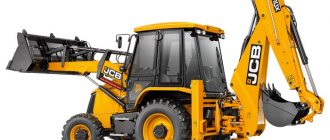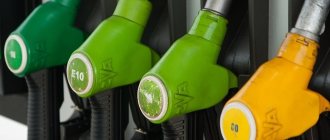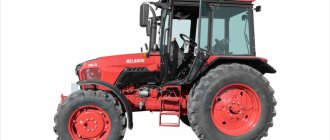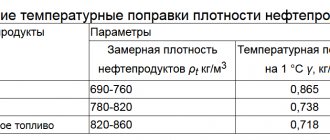How to determine the consumption rate for 1 engine hour?
It is calculated as follows:
Q = Nq/(1000Rk1) , where:
- N is the power of the power unit;
- q is the indicator of specific fuel consumption of the loader;
- R is the density of the fuel (diesel). Usually taken at the level of 0.85 kg/dm3;
- k1 is the percentage ratio of the operating time at maximum crankshaft speed.
The power of the power unit, as well as the specific fuel consumption, can be found in the maintenance instructions. The data is included in it in the form of a graph. It is built by specialists from the manufacturing plant. The basis for this is the results of tests in different modes. In practice, achieving the maximum speed of the power unit is very simple - press the gas pedal all the way. As a result, the loader accelerates, overcomes the rise with the load, lifts it to the maximum permissible height and all this, mind you, at maximum speed. Of course, in this mode the loader will only work for part of the shift. Therefore, it is necessary to use a coefficient designated as k1: it characterizes operation at maximum speed. It can be called an individual indicator of the specifics of the loader’s operation.
How many engine hours in one hour
The easiest way is to calculate what one engine hour is equal to on power units installed permanently, the crankshaft rotation speed of which is constant, as the engine operates in a single mode. When working with agricultural machinery, it is important to understand how the hour meter on a tractor works, how this parameter is recorded, and what the engine hour is on a medium-power tractor.
Calculation example
Let's assume that a diesel forklift was rented to load trucks and unload wagons. It works for the entire shift (8 hours), without overcoming slopes and without using the maximum fork lift height, since the sites it serves are located at a height of only 1,500-2,000 mm. The maximum engine speed is only used when the unit is accelerating to cover the distance between the loading and unloading areas. This operation takes approximately 30% of working time.
But it may be so. The company operates 24 hours a day. But shipment of materials (products) during this time is carried out only 2 times for 2 hours. The remaining time the loader is operated with minimal or medium intensity.
Accordingly, the coefficient characterizing the ratio of operating time with load (maximum/minimum) is lower in the second case. Its value can be accurately determined by measuring the time during which the loader overcomes the resistance of the surface (road) and lifts loads of maximum weight. Summing up the indicators, we obtain the operating time during which maximum loads are applied to the unit. And it is this time that needs to be subtracted from the duration of the (total) one shift.
The required coefficient is the ratio of operating time with minimum and maximum load (70% and 30%, respectively). Therefore, if the forklift was used with a maximum load of 30%, then the value of the coefficient is found by dividing 70% by 30% (that is, the value is 2.3).
For example, the well-known AX50 loader model from Komatsu is equipped with a 4D92E power unit. Its power is 33.8 hp. With. In the event that 30% of the entire work shift is operated at maximum speed, then the fuel consumption for 1 engine hour will be: 33.8x202/(1000x0.85x2.3) = 3.49 liters.
On the practical aspects of fuel consumption rates
Of course, there are certain differences between theoretical calculations and practice. Fuel consumption is affected not only by the duration of operation at maximum speed, but also by the power of the power unit and specific fuel consumption.
Equipment that has not been run-in and loaders with an impressive mileage demonstrate higher fuel consumption than those whose engines have been adjusted. Excessive consumption can also be detected during special testing in the case of operation at maximum load. For example, a one and a half ton car can show consumption from 5 to 6 liters per hour, although the average value of this indicator is 3 liters per hour.
It should also be noted that in real conditions the power unit is subject to less load than during test tests. To determine fuel consumption for write-off, you need to carry out a series of control measurements.
As an example, let's take the timing of the BX50 forklift from Komatsu (power unit - FD30T-16, load capacity - 3,000 kilograms). Type of work operations - unloading trucks, as well as placing cargo in cars. The work is performed for 9 hours every day. Fuel consumption is 2.5 liters per hour of operation.
With the 4D92E power unit, with a shift duration of 24 hours, the fuel consumption of the equipment is:
- for loaders with a lifting capacity from 1,500 to 1,800 kilograms - 1.7 liters per hour;
- for loaders with a lifting capacity from 2,000 to 2,500 kilograms - 2.5 liters per hour.
With an eight-hour shift, the consumption of a loader with a lifting capacity of 1,500 kilograms is 2.2 liters, and with a lifting capacity of 1,800 kilograms - up to 2.95 liters per hour.
How to calculate the fuel consumption rate of a forklift for one hour?
The fuel consumption rate is determined by the following formula:
- q is the specific fuel consumption*,
- N — engine power, hp. *,
- R is the density of diesel fuel (0.85 kg/dm 3 ),
- k1 is the ratio of operating time at the crankshaft rotation speed (maximum), expressed as a percentage.
* - data from the power characteristic curve is used
Specific fuel consumption and engine power can be found in the maintenance instructions, which include data in the form of a specific fuel consumption curve constructed by the manufacturer’s specialists based on the results of testing the engine in various modes.
In practice, the maximum engine speed is achieved in a simple way: the accelerator pedal is depressed all the way. And the loader accelerates, goes uphill with a load, lifts the load to the maximum height at maximum speed. Of course, in this mode the machine only works for part of the shift. This leads to the need to use the coefficient k1, which characterizes operation at maximum speed. This is a kind of individual indicator of the specifics of the work process.
Forklift fuel consumption rate. Practical aspects
Practice is a little different from theoretical calculations. Fuel consumption figures are influenced by the length of time the forklift is operating at maximum speed, specific fuel consumption and engine power. New equipment that has not been run-in or vehicles with high mileage show higher consumption than those on which the engine has already been tuned. Excessive fuel consumption will also be revealed during special testing when working with maximum load: a 1.5-ton forklift can show a consumption of 5.6 liters per hour (with an average rate of 3 liters per hour).
It is worth noting that the load on the engine in real conditions is less than under test conditions. To determine fuel consumption for write-off, it is necessary to carry out control measurements.
Here is the timing for the Komatsu BX50 forklift. Work operations: moving goods into cars, unloading trucks.
What malfunctions increase fuel consumption • Similar posts
| Fuel consumption by calculation (mathematical calculation) | Wialon Hosting In addition, if necessary, you can always purchase separately and install additional equipment, such as jibs, hooks, grabs for logs, etc. Fuel consumption by an excavator under normal conditions, limited by complexity, there are some indicators, the accuracy of which requires taking into account the skill of the operator, quality fuel, duty cycle type and material. |
| Fuel write-off by engine hours on tractors These standards are indicated in the methodological recommendations, and for use in the calculator they were entered on the website, see the reference book Standard value of fuel consumption. When calculating, you need to remember that different equipment equipment gives different indicators, and at the same time, under working conditions, the load is not always full, which can greatly affect the result. |
- when operating an agricultural machine at idle speed, 1 engine hour is equivalent to one full hour of real time;
- with normal load on the tractor, one engine hour is accelerated by about a third, thus amounting to 40 minutes of real time;
- in case of operation of the unit under maximum loads, 1 engine hour is equal to 20 minutes of real time.
Calculation of fuel consumption rates for a forklift
Fuel consumption standards for a forklift are one of the main issues that any owner of this equipment faces. Sometimes the manufacturer indicates fuel consumption per unit of power (horsepower or kilowatts) in grams. This information can be found in the forklift specifications table, but it does not always give a clear picture of actual consumption.
The rate of fuel consumption per engine hour is calculated using the formula:
An example of drawing up an act for writing off fuel and lubricants
- At the beginning of the act, on the right or left (it doesn’t matter), a place is allocated for approval by the head of the company, the name of the enterprise and the date of drawing up the act are indicated.
- Next, in the middle, enter the name of the document and briefly indicate its meaning (in this case, it is “write-off of fuel and lubricants”).
- After this, the composition of the commission is entered into the act, indicating the positions of the employees, as well as their personal data.
- The next thing to note is the period for which fuels and lubricants are written off, as well as the make and state number of a particular vehicle.
- Below is the table. They fit into it
- fuels and lubricants subject to write-off,
- their quantity (in liters),
- the norm of their consumption approved at the enterprise,
- actual consumption,
- price.
In those lines that remain blank, you need to put dashes.
- Under the table, the direction of expenditure should be noted: in this case, these are “the needs of the organization,” as well as the documents attached to the act (the waybills are listed here in chronological order by number).
- At the end, the act should be certified by the signatures of all members of the commission with transcripts of autographs.
Q = Nq/(1000Rk1) , where:
N — engine power (in hp);
q is the indicator of specific fuel consumption of the loader;
R is the density of the fuel (diesel). Usually taken at the level of 0.85 kg/dm3;
k1 is the percentage ratio of the operating time at maximum crankshaft speed.
Engine power and specific fuel consumption can be found in the maintenance instructions. The data is included in it in the form of a graph. The schedule is created by specialists from the manufacturing plant. The basis for this is the results of tests in different modes. In practice, the maximum engine speed can be achieved by pressing the accelerator pedal all the way. Of course, in this mode the loader will only work for part of the shift. Therefore, it is necessary to use a coefficient designated as k1. This coefficient characterizes what part of the work shift the loader operates at maximum loads. It can be called an individual indicator of the specific operation of the loader.
Table of contents:
However, in some crossovers, this saving may only be an appearance, since it often happens that the overpayment for a diesel engine for a crossover is so high that even its fuel economy savings do not pay for all these costs. Regarding the question of what is more economical: diesel or gasoline, we would recommend calculating the savings and benefits yourself using our car calculator AUTO-CALCULATOR.
Calculation example
Let's assume that the company has a diesel forklift. It works a full shift (8 hours), without overcoming slopes and without using the maximum fork lifting height, since the sites it serves are located at a height of 1.5 - 2 meters. The maximum speed is only used when the machine is accelerating to cover the distance between the loading and unloading areas. This operation takes approximately 30% of working time.
The exact value of k1 can be determined by measuring the time during which the loader accelerates, overcomes inclines and lifts loads of maximum weight. Summing up the indicators, we obtain the operating time during which maximum loads are applied to the unit. And it is this time that needs to be subtracted from the duration of the shift.
The required coefficient is the ratio of operating time with minimum and maximum load (70% and 30%, respectively). Therefore, if the forklift was used at maximum load 30% of the time, the value of the coefficient is found by dividing 70% by 30% (that is, the value is 2.3).
For example, the loader is equipped with an engine with a power of 33.8 liters. With. In the event that 30% of the entire work shift is operated at maximum speed, then the fuel consumption for 1 engine hour will be: 33.8x202/(1000x0.85x2.3) = 3.49 liters.
Fuel consumption is, of course, affected not only by the duration of operation at maximum speed, but also by engine power and specific fuel consumption.
Equipment that has not been run-in, as well as loaders with high mileage, demonstrate higher fuel consumption. Excessive consumption can also be detected during special testing in the case of operation at maximum load. For example, a loader may show a consumption of 5 to 6 liters per hour, although the average value of this indicator is 3 liters per hour.
It should also be noted that in real conditions the engine is subject to less load than during test tests. To determine fuel consumption for write-off, you need to carry out a series of control measurements.
As an example, let's take the timing of the BX50 forklift from Komatsu (engine - FD30T-16, load capacity - 3,000 kilograms). Type of work operations - unloading trucks, as well as placing cargo in cars. The work is performed for 9 hours every day. Fuel consumption is 2.5 liters per hour of operation.
With the 4D92E power unit, with a shift duration of 24 hours, the fuel consumption of the equipment is:
- for loaders with a lifting capacity from 1,500 to 1,800 kilograms - 1.7 liters per hour;
- for loaders with a lifting capacity from 2,000 to 2,500 kilograms - 2.5 liters per hour.
With an eight-hour shift, the consumption of a loader with a lifting capacity of 1,500 kilograms is 2.2 liters, and with a lifting capacity of 1,800 kilograms - up to 2.95 liters per hour.
The importance of forklift maintenance and its frequency
There is a misconception that if the forklift is just sitting there and no one is using it, then maintenance is not needed. However, the opposite is true: when moving, components and mechanisms are lubricated, so equipment standing idle can become unusable much faster.
Forklift maintenance is also necessary when the safety margin of a particular joint comes to an end. Based on the service life of the elements, engine hour readings and the age of the forklift, the frequency of scheduled maintenance is calculated.
Engine hour concept
Special equipment is equipped with an engine hour sensor - a device that helps keep under control the duration and efficiency of full engine operation. Its operation is simple: as soon as the motor is turned on, a counter (electrical or mechanical) is started, which begins to record information about the frequency of rotation of the shaft, using an indicator specially designed for this purpose. On electric equipment, the sensor turns on when the operator is sitting on the seat (the limit switch is closed), on diesel equipment - when the engine is running
Using such a device, you can find out the duration of operation of equipment for any time period. Therefore, it is important to understand that 1 engine hour is not equal to one hour of actual operating time.
How to calculate engine hours yourself?
The calculation is based on the number of revolutions per minute. And it is worth understanding that this indicator differs significantly at idle and under load.
There are rules for counting them:
- idling 1 hour = 2 normal hours
- under standard load 1 hour = approximately 2 hours
- under intensive load 1 engine hour = approximately an hour
The cyclical use of equipment requires a separate calculation of engine hours in order to obtain more accurate data on the wear of the mechanisms. In this case, it is worth taking into account the age of the special equipment, the specifics of the work performed, as well as the percentage of wear of the main components.
Conversion to kilometers
It is also not possible to derive an exact formula for what 1 engine hour is equal to in km. For passenger cars, it can be approximately equated to 12-14 kilometers of quiet driving at moderate speeds or idling the engine. Thus, 15 thousand km is the standard interval for changing oil and some other consumables - this is about 200–250 hours of engine operation.
When driving aggressively, driving on bad roads, transporting cargo or towing, which often requires using full engine power, the engine hours will be “used up” faster. And if the car is driven on busy streets or often idles warm up, these units of measurement become more than mileage. After all, the car is stationary, and the resource of the engine and some other units is consumed. That is why, when replacing consumables, it is better to focus on motorcycle hours rather than mileage.
Engine hour consumption is recorded by a special device.
The issue of accurate calculation is especially important for vehicle drivers working far from qualified assistance (in forest areas, facilities under construction, extreme recreation). They need to know the production so that they can replace or inspect parts in time to avoid unexpected breakdowns. If you can’t rely on mileage, it’s worth purchasing a meter.
Features of maintenance of gasoline forklifts
Gasoline equipment requires a thorough inspection of all working components during each maintenance; all parts of the forklift are diagnosed. In this case, the type of maintenance is established (TO-1, TO-2, TO-3, annual maintenance), which is determined based on the total number of engine hours worked.
During maintenance, depending on the operating time, different fluids are changed: oils
- all technical fluids
- oil and air filters
- filter elements
During maintenance, all components are lubricated, all fasteners are checked and, if necessary, tightened, a check is carried out for deformation and corrosion, the condition of the mast and carriage rollers is recorded, etc.
Options for accounting for fuel and lubricants in 1C: Accounting 8
Fuel can be purchased in cash or non-cash. If the organization has chosen a non-cash form, then a supply agreement is concluded with the fuel supplier, according to which the organization transfers funds to the supplier’s bank account, and in return receives coupons or fuel cards, with which drivers refuel cars at gas stations (gas stations).
Accounting for fuel and lubricants using coupons
To account for transactions using fuel coupons, it matters what type of coupons are used and at what point the ownership of fuel and lubricants is transferred to the organization. Depending on the terms of the agreement for the supply of petroleum products, ownership of the gasoline received may pass to the organization either at the time of receipt of coupons or at the time of refueling the car at a gas station.
If, under an agreement with the supplier, ownership of fuels and lubricants is transferred to the organization at the time of refueling the car at a gas station, then coupons for fuels and lubricants can be taken into account as part of monetary documents in account 50.03 “Cash documents”.
In the program "1C: Accounting 8" (rev. 3.0), the following documents are used for accounting for fuel as part of monetary documents:
- Receipt of monetary documents and Issuance of monetary documents (section Bank and cash desk) - to register the receipt of coupons from the supplier and transfer them to the driver;
- Advance report (section Bank and cash desk) - to reflect the purchase of fuel and lubricants;
- Request invoice (Warehouse section) - for writing off purchased fuel and lubricants as expenses.
If, under an agreement with the supplier, ownership of fuel and lubricants passes to the organization at the time of transfer of fuel coupons, then the supplier, simultaneously with the coupons, transfers to the organization a set of documents for fuel (waybill, invoice). In this case, it is necessary to stipulate in the contract that the fuel is in responsible storage with the supplier until the fuel coupon is presented and fuel is poured into the car tank. The receipt and issuance of coupons for fuel and lubricants should be registered in a special journal - the coupon book.
In the program “1C: Accounting 8” (rev. 3.0), the following documents are used to account for fuel and lubricants with the transfer of ownership at the time of receipt of coupons:
- Receipts (acts, invoices) (Purchases section) - to register the purchase of fuel;
- Movement of goods (Warehouse section) - to reflect the actual filling of fuel from the gas station into the tank of the car;
- Request invoice (Warehouse section) - for writing off fuel as an expense.
| 1C:ITS For more information about accounting for fuel and lubricants in cash and using coupons, see the section “Instructions for accounting in 1C programs”: “Purchase of fuel and lubricants using an advance report (sales receipt without an invoice)”, “Accounting for fuel and lubricants using coupons with transfer of ownership at the moment receipt of coupons”, “Accounting for fuel and lubricants using coupons with transfer of ownership at the time of receipt of coupons”. |
Accounting for fuel and lubricants using a fuel card
A fuel card is a microprocessor-based non-bank plastic card with a PIN code and a chip that carries information:
- on established limits, quantity and range of petroleum products and related services;
- and/or the amount of money within which petroleum products and related services can be obtained at a gas station.
To purchase fuel using cards, the company enters into an agreement with the fuel supplier (this can be a processing center that acts as the issuer of the fuel card and operates under commission agreements with fuel owners). Depending on the terms of the contract, the fuel card can be transferred to the organization and serviced free of charge or for a fee.
An organization may have several fuel cards at its disposal. Fuel cards in an organization are assigned either to the driver or to the vehicle. Neither money nor liters are credited to each individual card. The supplier stores information as a whole for the entire purchasing organization, and the fuel card is a technical means for individual drivers to obtain fuel and services at a gas station.
When receiving fuel at a gas station, the driver receives a receipt confirming the refueling completed, which should be attached to the waybill. At the time specified in the contract (at the end of the month or more often), the fuel supplier provides the organization with a set of documents for the specified period:
- report on the brand and quantity of fuel provided (register of transactions carried out using fuel cards);
- financial documents (delivery note and invoice).
In the program “1C: Accounting 8” (rev. 3.0), Receipt documents (acts, invoices) are used to reflect the receipt of fuel cards and fuels and lubricants. The transfer of the card is formalized by the document Transfer of materials into operation (Warehouse section), and the accounting of fuels and lubricants in expenses is documented by the document Requirement-invoice.
| 1C:ITS For more information about accounting for fuels and lubricants using fuel cards, see the section “Instructions for accounting in 1C programs”: “Accounting for fuels and lubricants using fuel cards.” |
As you can see, “traditional” fuel accounting methods are quite labor-intensive. At the same time, in previous versions of the program there was no printed form of the waybill.
Features of maintenance of electric forklifts
When servicing electric forklifts, almost all the same rules are followed as when servicing gasoline equipment.
The difference is that they do not need to change the oil in the engine and gearbox, since electrical equipment does not have these components. The optimal maintenance frequency is considered to be 1000 operating hours. In addition, a time period of 12 months is also established.
Batteries require special attention. Especially traction batteries, which need to be periodically charged and maintained. It is worth making sure that the charge level never drops below 30%. Another point is that it is necessary to monitor the electrolyte level, since a lot of liquid evaporates during the operation of the battery. If you do not add distilled water in a timely manner, the battery will quickly fail.
Timely maintenance of a forklift can guarantee the reliability and safety of its use, and is also guaranteed to extend its service life.
How much fuel does a diesel forklift consume?
It is estimated that in the Russian market of counterbalanced forklifts the ratio of equipment with an internal combustion engine and an electric drive is 68%:32%. The predominance of forklifts is explained by the fact that industrialization processes (industrial and construction development) in our country are still a greater incentive for the loading equipment market than the development of warehouse logistics. That is, currently the main consumers of forklifts in Russia are enterprises and companies from various industries, and not logistics, although the latter is developing at a fairly rapid pace.
The operating features of the equipment also play a certain role: operation for a significant part of the year at low temperatures in open areas, coatings that are far from ideal, etc. A diesel engine requires lower costs for purchase, maintenance, and operation - it is a reliable, easy to maintain, powerful and efficient source of energy. In addition, such machines are produced in a wide range of carrying capacity (up to 43 tons) and with a wide range of attachments for performing various technological operations, and the exhaust gas purification system (particulate filters), used in the latest models of leading manufacturers, reduces harmful emissions by 70. 98%, which allows you to work indoors.
One of the characteristics of the “price of ownership” of a diesel forklift is fuel consumption. In the summary table of technical characteristics, the manufacturer often indicates specific fuel consumption in grams per unit of power measurement (hp or kW). Meanwhile, this parameter does not give an idea of how much a given engine will “eat” in practice, how much fuel will be consumed per hour, shift, per month, etc. For this, special techniques are used, one of which we will introduce readers.
Direct speech
Very often, customers directly state that they need solutions that will do everything they need with just the click of one or two buttons. That is, according to the “set it and forget it” formula. However, in this case this approach will not work.
We must understand that any technical system cannot completely eliminate the human factor. Just as automation does not cancel document flow - in our case we are talking about waybills.
Anyone who uses satellite monitoring systems knows that they will inevitably encounter discrepancies. For example, when the odometer shows one mileage, and GLONASS gives lower values. Or when the volume of fuel according to refueling documents does not match the actual data from the satellite system. One way or another, we need to work with these inconsistencies. Compare, find out, investigate, make administrative decisions.
Therefore, management needs to initially decide how to standardize fuel and lubricants and keep records, what indicators to take as a basis, who will do this and what threatens violators. All this must be formalized in the form of orders and communicated to the team.
With the right approach, the integration of software products such as 1C with GLONASS/GPS control systems can significantly improve the work of motor transport companies. But, again, you need to realize that automation programs have a management mission, and satellite systems perform a control function. Both have their own specifics, and during interaction, discrepancies are possible. Therefore, in order for an integrated solution to benefit the fleet, all aspects and a strategy for further work must be worked out in advance. An automation company must help with this.
Pavel Baranov, General Director
The application of the act for writing off fuels and lubricants (fuels and lubricants) occurs at all enterprises and organizations that have transport equipment on their balance sheets, employ drivers and incur the costs of purchasing the necessary consumables for cars. The concept of “fuels and lubricants” includes:
- petrol,
- oil,
- brake fluid,
- various types of lubricants, etc.,
that is, in fact, all those liquids that no transport unit can do without.
How to calculate fuel consumption rate
Let's say a loader has already been purchased and put on the balance sheet of the enterprise. The accounting department asks the employees of the official dealer's service center for estimated data for fuel write-off.
They, in turn, determine the fuel consumption rate using the formula
where Q is specific fuel consumption (data from the power characteristic curve);
N – power, hp. (data from the power characteristic curve);
R – density of diesel fuel (0.85 kg/dm 3 );
k1 – coefficient characterizing the percentage of operating time at maximum engine speed.
Engine power and specific fuel consumption are taken from the engine maintenance instructions used by the authorized dealer performing the service. The data is entered into it in the form of a specific fuel consumption curve, which is constructed by the manufacturing plant’s engineers based on the results of engine testing in various modes, including at maximum speed.
In practice, in order to achieve the maximum engine speed, we squeeze the accelerator pedal all the way, literally pushing it “to the floor.” In this mode, the machine accelerates, goes uphill with a load, or lifts a load to the maximum height at maximum speed. It is clear that the loader does not work this way for the entire shift, but only for some part of it. Hence the need to apply the coefficient k1. In fact, the coefficient characterizing operation at maximum speed is an indicator of the specifics of the enterprise’s technological cycle.
Fuel metering automation tools
Modern software products have greatly changed the work of transport workers. Unlike in previous years, they do not have to deal with many routine tasks, including paperwork. Programs such as “1C:Vehicle Management”, “1C:Enterprise 8. Transport logistics, forwarding and vehicle management”, “1C:TMS Logistics. Transportation Management”, as well as various modifications and analogues of these products have been implemented in almost all vehicle fleets.
Such programs include many basic capabilities, additional subsystems and modules for comprehensive transport management: planning, control, order distribution, depreciation calculation, payroll and much more.
In terms of accounting for fuel and lubricants, modern programs provide automatic accounting of the receipt and consumption of fuel for individual vehicles and employees, accounting according to norms and facts, maintaining a register of waybills, generating reports, etc.
Such programs often implement the ability to register gas stations for certain types (from a warehouse, for cash, using coupons). By the way, software integration with processing centers has developed rapidly in recent years. Thanks to this, detailed information about refueling using plastic cards at gas stations of leading players (Shell, Lukoil, TNK, Rosneft, Gazpromneft, etc.) is available in vehicle fleet accounting systems.
What's in practice?
A clear and visual indicator is the amount of fuel in liters consumed per hour of equipment operation by operating enterprises and organizations. It should also be noted here that theoretical calculations of fuel consumption for a forklift will always be slightly higher than in practice, since in real conditions the load on the engine is less than in test conditions. Therefore, to determine fuel consumption for write-off, it is necessary to carry out control measurements.
A kind of timing was performed for the Komatsu 3-ton diesel truck of the BX50 series (FD30T-16), operating from 12 to 21 o'clock, i.e. 9 hours daily. Technological operations: unloading trucks, moving goods into cars. Fuel consumption readings for the engine on the FD30T-16 Komatsu 4D94LE loader were 2.5 l/h.
For a number of other companies, we received the following data on fuel consumption of a Komatsu loader:
- 1.7 l/h – loader with a lifting capacity (g/p) of 1.5. 1.8 t (engine 4D92E), shift 24 hours;
- 2.5 l/h – loader capacity 2. 2.5 t (engine 4D94E), shift 24 hours;
- 2.2 l/h – loader with a capacity of 1.5 t (engine 4D92E), shift 8 hours;
- 2.9. 2.95 l/h – loader with a capacity of 1.8 t (4D92E engine), shift 8 hours or more.
Thus, fuel consumption indicators are influenced by such parameters as engine power and specific fuel consumption, and the duration of working hours when it operates at maximum speed. Cars with high mileage or, on the contrary, new ones, but not yet run-in, show higher fuel consumption than those on which the engine has been tuned. Fuel consumption higher than usual is shown by machines during special testing when operating at maximum load (for example, with an average rate of 3 l/h declared by the manufacturer, during a test a 1.5-ton loader can show a consumption of up to 5.6 l/h).
What is engine hour and why is this parameter used Toyota 7fg15
The difference is observed under different operating modes of the power unit, that is, when the loads are too increased or minimal, there will inevitably be discrepancies in the units of measurement. Methods for calculating engine hours for a diesel engine can be different, ranging from simple mental calculation, with further recording of engine performance indicators, to the installation of special mechanical or electrical meters.
| Tractor model | Fuel consumption |
| MTZ-80 | 5.5 l/hour |
| MTZ-82.1 | 5.5 l/hour |
| BELARUS-320 | 3.0 l/hour |
| BELARUS-1221 | 3.1 l/hour |
| YuMZ-6G | 5.8 l/hour |










